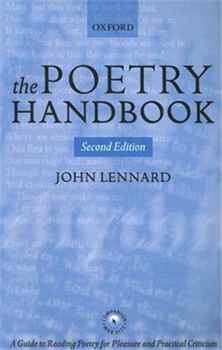Description
The Poetry Handbook is a lucid and entertaining guide to the poet's craft, and an invaluable introduction to practical criticism for students. Chapters on each element of poetry, from metre to gender, offer a wide-ranging general account, and end by looking at two or three poems from a small group (including works by Donne, Elizabeth Bishop, Geoffrey Hill, and Nobel Laureate Derek Walcott), to build up sustained analytical readings.Thorough and compact, with notes and quotations supplemented by detailed reference to the Norton Anthology of Poetry and a companion website with texts, links, and further discussion, The Poetry Handbook is indispensable for all school and undergraduate students of English. A final chapter addresses examinations of all kinds, and sample essays by undergraduates are posted on the website. Critical and scholarly terms are italicised and clearly explained, both in the text and in acomplete glossary; the volume also includes suggestions for further reading.The first edition, widely praised by teachers and students, showed how the pleasures of poetry are heightened by rigorous understanding and made that understanding readily available. This second edition -- revised, expanded, updated, and supported by a new companion website - confirm The Poetry Handbook as the best guide to poetry available in English.
About the Author
John Lennard (born 1964) read English at New College, Oxford, took an MA at Washington University in St Louis, and a DPhil. back at New College. After teaching for the Open University and the University of London, he was Fellow and Director of Studies in English at Trinity Hall, Cambridge, from 1991-8, and Professor of British and American Literature at the University of the West Indies, Mona, Jamaica, from 2004-09. He is now an Associate Member and Director of Studies in English at Hughes Hall, Cambridge, and a freelance writer as well as the general editor of Humanities-Ebooks' Genre Fiction Sightlines and Monographs series.Besides almost all books, he likes cats, cricket, mountains and forests, architecture, punctuation (and its peculiar history), red wine, honky-tonk piano, blues and folk, rugs, knots, jigsaws, crosswords, pottery, Golden Age Dutch fine art, and astronomy.
